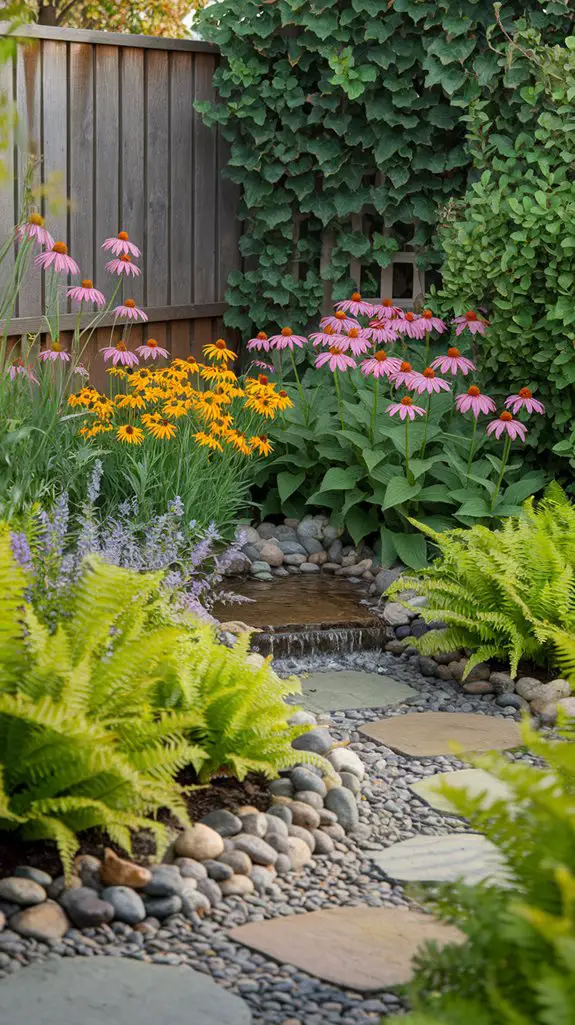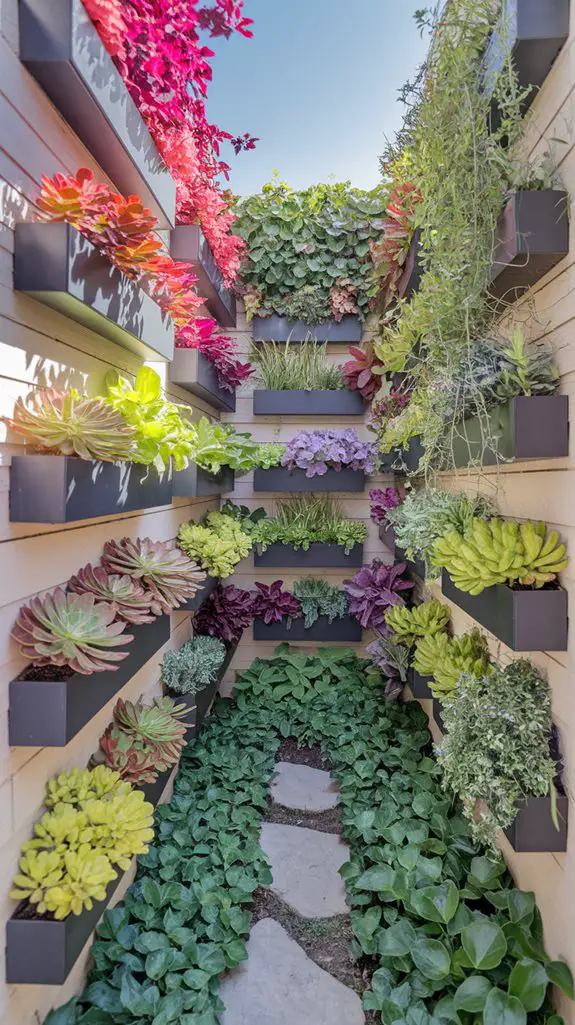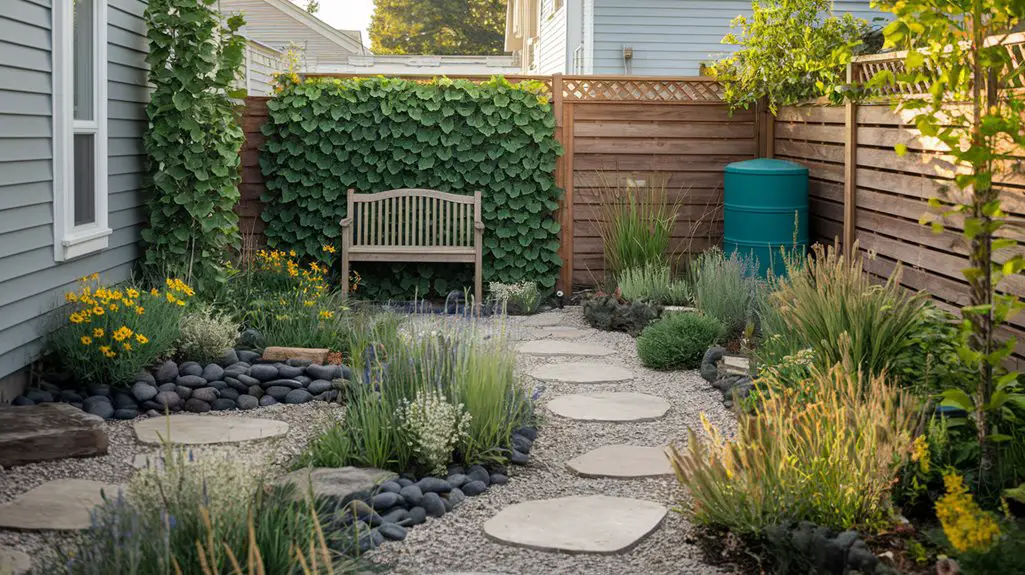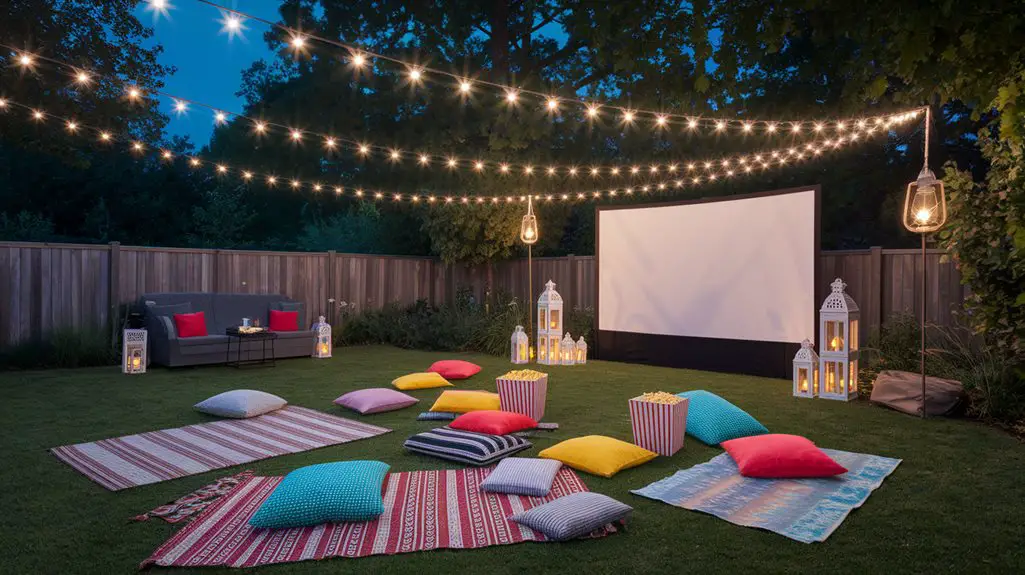Your small yard presents a perfect opportunity for eco-friendly landscaping innovations. You'll find that native plants, permeable pathways, and vertical gardening solutions can transform limited space into a sustainable oasis. By implementing water-saving irrigation systems and replacing traditional turf with drought-tolerant alternatives, you'll reduce both maintenance demands and environmental impact. These strategic choices not only conserve resources but also create vibrant microhabitats that support local wildlife ecosystems.
Choose Native Plants for Water Conservation
When planning an eco-friendly landscape design, native plants should be your first consideration for effective water conservation. Native species have evolved to thrive in your local climate conditions, requiring considerably less supplemental irrigation than exotic varieties.
They've developed root systems perfectly adapted to capture available moisture and withstand regional drought patterns.
Select plants indigenous to your specific microclimate—not just your state. You'll notice reduced water bills and decreased maintenance requirements.
Group plants with similar hydration needs together in hydrozones to maximize irrigation efficiency.
For best results, incorporate deep-rooted perennials like coneflower or black-eyed Susan in small yards. These establish extensive root networks that access groundwater effectively.
During installation, apply 2-3 inches of organic mulch around new plantings to retain soil moisture and suppress water-competing weeds. Additionally, incorporating wildlife-friendly practices can further enhance the ecological balance of your garden and support local ecosystems.
Create a Rain Garden to Manage Runoff

Rain gardens serve as both functional landscape features and effective stormwater management systems for eco-conscious homeowners. These shallow depressions, positioned strategically to collect runoff from impervious surfaces, help filter pollutants before water enters the groundwater system.
To construct your rain garden, select a location at least 10 feet from your foundation where water naturally collects. Excavate a depression 4-8 inches deep with gently sloping sides at a 3:1 ratio. Incorporate compost into existing soil to improve drainage and install deep-rooted native plants that tolerate both wet and dry conditions.
Additionally, integrating rainwater systems can enhance the overall effectiveness of your rain garden by directing excess runoff into the pond, further promoting water quality. Choose species like swamp milkweed, blue flag iris, and switchgrass that can withstand periodic inundation. Size your garden to approximately 20-30% of your roof's drainage area for peak performance.
Implement Vertical Gardening to Maximize Space

Vertical gardening transforms limited outdoor spaces into productive, eco-friendly growing environments while reducing your landscaping's overall environmental footprint. By utilizing walls, fences, and trellises, you'll create habitat diversity while minimizing ground-level soil disruption. Install modular wall systems with integrated irrigation to maximize water efficiency and minimize runoff.
- Select appropriate plant combinations based on solar exposure—place sun-loving species at the top and shade-tolerant varieties below to create microclimates.
- Incorporate recirculating hydroponic systems to reduce water consumption by up to 90% compared to traditional gardening methods.
- Choose lightweight growing mediums such as coco coir or vermiculite blends to reduce structural load requirements while improving aeration and moisture retention. Additionally, vertical gardening systems allow for innovative solutions to fit various small yard configurations.
Design a Permeable Pathway System
Transforming your outdoor spaces with permeable pathway systems offers numerous environmental benefits while enhancing the aesthetic appeal of your landscape design. These pathways allow rainwater to infiltrate the soil rather than creating problematic runoff.
Select materials like crushed stone, decomposed granite, or specialized permeable pavers for maximum functionality. Install a proper foundation with 3-5 inches of compacted gravel beneath your surface material to guarantee drainage and stability. Maintain at least a 2% slope away from your home's foundation to prevent water pooling.
You'll reduce water pollution by naturally filtering contaminants through soil layers while simultaneously recharging groundwater supplies. Additionally, using eco-friendly mulch options can further enhance your garden's sustainability and improve soil health.
For maximum eco-performance, border your pathways with native plants that thrive in your local conditions, creating a cohesive system that manages stormwater effectively while providing accessible routes throughout your yard.
Install a Drip Irrigation System
When considering sustainable water management strategies for your landscape, a drip irrigation system stands as one of the most efficient solutions available. This method delivers water directly to plant roots, minimizing evaporation and runoff while reducing water consumption by up to 60% compared to sprinkler systems. Additionally, implementing sustainable rainwater harvesting can further enhance your landscape's water efficiency.
To maximize your drip irrigation system's effectiveness:
- Install pressure regulators and filters to prevent clogging and guarantee consistent water flow through the emitters.
- Group plants with similar water requirements in hydrozones, allowing for customized irrigation scheduling based on specific plant needs.
- Incorporate a smart controller that adjusts watering schedules according to weather conditions, soil moisture levels, and seasonal requirements.
Select UV-resistant tubing and high-quality components to extend system longevity.
Position emitters at the plant's drip line rather than directly at the stem.
Compost Kitchen Waste for Natural Fertilizer
Composting not only reduces waste but also promotes eco-friendly practices in your garden. Beyond water conservation, nourishing your landscape with home-produced organic matter creates a perfect ecological loop in your garden.
Start by collecting fruit peels, vegetable scraps, coffee grounds, and eggshells in a dedicated container. Avoid meat, dairy, and oily foods that attract pests and slow decomposition.
Layer your compost with a 3:1 ratio of brown materials (dried leaves, paper) to green materials (kitchen waste). Turn the pile weekly to accelerate breakdown and prevent odors. A properly managed compost heap reaches 135-160°F internally, killing pathogens and weed seeds.
After 3-6 months, you'll have nutrient-rich humus that improves soil structure, enhances microbial activity, and provides slow-release nutrients.
Apply 1-2 inches around plants biannually, keeping it away from stems to prevent rot.
Incorporate Pollinator-Friendly Plant Varieties
A diverse selection of pollinator-friendly plants forms the backbone of any sustainable landscape ecosystem. By integrating native flowering species that bloom sequentially throughout the growing season, you'll create a continuous nectar source for bees, butterflies, and hummingbirds while enhancing biodiversity in your yard.
- Select region-specific natives such as coneflower, milkweed, and blazing star that have co-evolved with local pollinators and require minimal supplemental irrigation once established.
- Plant in clusters of at least three specimens per species to increase visibility and accessibility for pollinators traversing your landscape.
- Incorporate varied bloom shapes and sizes (tubular, flat, and composite) to accommodate different pollinator feeding mechanisms and tongues lengths.
Avoid pesticides on these plantings to maintain a toxin-free habitat for beneficial insects. Additionally, incorporating wildlife habitats with native plants can significantly improve the ecological health of your yard.
Use Recycled Materials for Garden Borders
Creating defined borders for your garden beds doesn't require purchasing new materials, as numerous recycled alternatives can serve this purpose effectively while reducing environmental impact. You'll find these options add character while diverting items from landfills. Additionally, consider implementing stylish privacy fencing ideas, which can enhance your small backyard's aesthetic while providing a sense of seclusion.
| Material | Environmental Benefits | Installation Tips |
|---|---|---|
| Wine Bottles | Upcycles glass waste | Bury 1/3 depth, neck-down |
| Salvaged Brick | Diverts construction waste | Set in sand base for stability |
| Fallen Tree Limbs | Zero carbon footprint | Treat with borate for longevity |
Consider sourcing materials from neighborhood cleanup events, construction sites (with permission), or online marketplaces where others discard usable items. When installing recycled borders, verify proper drainage by creating small gaps between materials and maintaining a slight slope away from your planting areas to prevent water accumulation during heavy rainfall.
Replace Lawn Areas With Ground Cover Alternatives
While recycled borders enhance garden aesthetics, the lawn space between them often consumes excessive resources.
Traditional turf requires frequent watering, mowing, and chemical treatments that harm local ecosystems.
Consider replacing high-maintenance grass with drought-tolerant ground cover alternatives that provide environmental benefits while reducing your outdoor maintenance commitment.
- Microclover (Trifolium repens) – Stays green with minimal irrigation, fixes nitrogen naturally, and tolerates light foot traffic while reducing the need for fertilizer applications.
- Creeping Thyme (Thymus serpyllum) – Forms a dense, aromatic mat that suppresses weeds, attracts pollinators, and requires zero mowing while thriving in poor soil conditions.
- Sedum varieties – Establish quickly in sunny locations, store water efficiently in fleshy leaves, and create textural interest throughout changing seasons with minimal resource inputs. Additionally, these ground cover options can contribute to sustainable landscaping ideas by enhancing biodiversity and soil health.
Conclusion
You've now mastered the essentials of eco-friendly small yard landscaping. By implementing these sustainable techniques, you'll create a space that's not only visually appealing but also supports local ecosystems with virtually zero environmental impact. Remember that your small yard can make an enormous difference—even the tiniest pollinator garden can support thousands of beneficial insects annually. Continue refining your approach as seasonal needs change, and you'll enjoy a beautiful, sustainable outdoor space for years to come.




